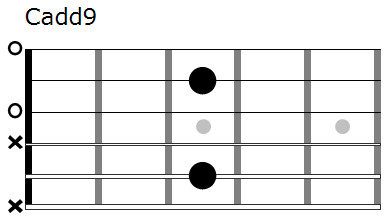Chords are the foundation for most guitarists when they first pick up the instrument.
Just think about the countless songs you can play with a few basic chords. Using a capo can simplify things even further, allowing you to transpose chords across different positions on the neck.
Sounds great, doesn’t it?
However, relying on the same chords repeatedly is a common reason why guitarists lose interest.
Songs start to sound alike, and you might find yourself wondering, “How can I discover new chords?” or “When will I learn more advanced chords?”
In this fingerstyle guitar lesson, we’ll explore nine Cool Guitar Chords and demonstrate how to incorporate them into your playing.
Once we introduce each chord, we’ll show you how to use it within a beautiful chord progression.
Here are the cool chords we’ll be learning:
- Cadd9
- Gsus4
- Em9
- Am(add9)
- Amaj7
- Dsus2 and Dsus4
- Bb13
- C#m9
- Emaj7
Understanding Extended Chords
Before diving into the chords themselves, let’s briefly discuss extended chords.
Many of the chords we’re about to learn are extended chords. An extended chord is essentially a basic chord that includes additional notes from the musical scale, adding richness and complexity.
Here’s the key difference between basic and extended chords:
- Basic chords (Triads) are built with three notes: the root, the 3rd, and the 5th. The root note names the chord, the 3rd determines if it’s major or minor, and the 5th can be perfect, diminished, or augmented.
- Extended chords add extra notes like the 7th, 9th, 11th, and 13th to these basic triads. These added notes create beautiful colors and textures beyond simple major or minor sounds.
Get ready to enhance your chord vocabulary!
1. Cadd9 Chord
The Cadd9 chord is an extended chord that works beautifully in major keys like C major and G major, as well as relative minor keys such as A minor or E minor.
It’s essentially a C major triad with an added major 9th.
The notes in a Cadd9 chord are C, E, G, and D (root, major 3rd, perfect 5th, and major 9th).
Here’s the Cadd9 chord diagram:
 Cadd9 chord diagram for guitar
Cadd9 chord diagram for guitar
The Cadd9 is a fantastic open chord that transitions smoothly with chords like G or E minor. The added D note creates a pleasant resonance, especially with the open high E string.
Here’s a chord progression to try: Cadd9 | G | Am | Fadd9|. Note that the F chord is also played as an add9 chord in this progression.
2. Gsus4 Chord
The Gsus4 is a widely used and versatile guitar chord.
Often called a “Suspended” chord, the Sus4 chord is an extended chord built with the root, 4th, and 5th degrees of the scale.
The “Suspended” label comes from the fact that this chord lacks a 3rd, making it neither definitively major nor minor.
The notes of the Gsus4 chord are G, C, and D (Root, perfect 4th, and perfect 5th).
Here’s the Gsus4 chord diagram:
One of the great things about the Gsus4 chord is its flexibility for creating simple melodic movement within chord voicings.
By moving the 4th (C note) back down to the 3rd (B note), you can create simple, effective melodic ideas. Explore this transition in your playing.
3. Em9 Chord
The Em9 chord is undeniably one of the most beloved chords on the guitar.
The close interval between the F# and G notes within the chord is a key element of its appealing sound.
A minor 9th (m9) chord contains the root, minor 3rd, perfect 5th, minor 7th, and major 9th. Even though the “minor 7th” isn’t explicitly in the chord name “m9”, it’s understood to be part of the chord structure.
The notes in an Em9 chord are E, G, B, D, and F#.
Here’s the Em9 chord diagram:
 Em9 chord diagram for guitar players
Em9 chord diagram for guitar players
The magic of the Em9 lies in the close intervals – the F# and G, and also the D and E. These create a rich, almost bittersweet harmony.
This chord lends itself beautifully to progressions like: Em9 | Cadd9 | G | D |.
Experiment with this progression and listen to how the Em9 adds depth and emotion.
4. Am(add9) Chord
The Am(add9) chord is another fantastic chord that bridges the gap between beginner and intermediate guitar playing.
This chord can require a bit of a stretch for the pinky finger initially. Proper left-hand positioning is crucial for comfortable playing.
An “add9” chord is a basic triad with a major 9th added. The notes of the Am(add9) chord are A, C, E, and B (Root, minor 3rd, perfect 5th, and major 9th).
Here’s the Am(add9) chord diagram:
 Am(add9) chord diagram for guitar
Am(add9) chord diagram for guitar
The Am(add9) has a unique, slightly exotic sound. Once you get past the initial finger stretch, you’ll likely find yourself using this chord frequently.
Try this chord progression: Am(add9) | Am(add9)/G | Fmaj7 | % |. Repeat the Fmaj7 for two measures. The Am(add9)/G indicates playing Am(add9) with a G bass note.
5. Amaj7 Chord
If you had to describe the Amaj7 chord in one word, “Dreamy” would be a strong contender.
The major 7th (maj7) chord family is incredibly rewarding to explore, learn, and use in your music.
The Amaj7 chord is a major triad with an added major 7th. The notes are A, C#, E, and G# (Root, major 3rd, perfect 5th, and major 7th).
Here is the Amaj7 chord diagram:
It’s almost effortless to create beautiful chord progressions when you start with a chord as rich as Amaj7.
In this example, we’ll play: Amaj7 | Dmaj7 | Amaj7 | Esus4 |. Notice how the major 7th chords create a smooth, sophisticated sound.
6. Dsus2 and Dsus4 Chords
Let’s explore more suspended chords, this time in the key of D major.
As mentioned before, a suspended chord omits the 3rd degree of the scale.
The difference between Sus2 and Sus4 chords lies in how the 3rd is “suspended”:
- Sus2: The 3rd is lowered to the 2nd.
- Sus4: The 3rd is raised to the 4th.
The notes for Dsus2 are D, E, and A (root, major 2nd, and perfect 5th). The notes for Dsus4 are D, G, and A (Root, perfect 4th, perfect 5th).
Here’s the chord diagram for both Dsus2 and Dsus4:
 Dsus2 and Dsus4 chord diagrams for guitar
Dsus2 and Dsus4 chord diagrams for guitar
Using Dsus2 and Dsus4 together in a chord progression opens up fantastic possibilities. You could even write an entire song using just these two chords and variations!
Let’s look at a simple example.
7. Bb13 Chord
Let’s venture into a jazzy sound with the Bb13 chord.
13th chords are extended chords that include the root, 3rd, 5th, 7th, and 13th degrees. Like the Em9, the Bb13 also implicitly includes the 7th, even if it’s not stated in the name alone.
For Bb13, the notes are Bb, D, F, Ab, and G (Root, major 3rd, perfect 4th, minor 7th, and major 13th). Note: There seems to be a typo in the original article listing perfect 4th instead of perfect 5th. It should be Root, major 3rd, perfect 5th, minor 7th and major 13th.
Here’s the Bb13 chord diagram:
 Bb13 chord diagram for jazz guitar
Bb13 chord diagram for jazz guitar
With a chord as jazzy as Bb13, jazzy chord progressions are a natural fit.
In this example, we’ll play: Ebm9 | Bb13 | Dbmaj7 | Dbmaj9 |. Some of these chords, especially Bb13, can be a stretch, so practice them slowly and deliberately.
8. C#m9 Chord
Let me introduce you to one of my personal favorites: the C#m9 chord.
This chord is incredibly beautiful and works well with both strumming and fingerpicking styles. It’s a minor chord with added 7th and 9th extensions.
The notes of the C#m9 chord are C#, E, G#, B, and D# (Root, minor 3rd, perfect 5th, minor 7th, and major 9th).
Here’s the diagram for this gorgeous chord:
 C#m9 chord diagram for guitarists
C#m9 chord diagram for guitarists
C#m9 pairs wonderfully with chords like A, E, F#m, and B major. Adding extensions to those accompanying chords can create even richer harmonic textures.
Here’s a sample chord progression featuring the C#m9 chord.
9. Emaj7 Chord
Last but certainly not least on this list of cool chords is the Emaj7.
This chord is a major triad with an added major 7th interval.
The notes are E, G#, B, and D# (Root, major 3rd, perfect 5th, and major 7th).
Here’s the diagram for the Emaj7 chord:
 Emaj7 chord diagram for guitar
Emaj7 chord diagram for guitar
The Emaj7 is another dreamy and evocative chord that blends well with Amaj7, C#m9, or B major. In this example, we’ll focus on a simple progression: Emaj7 | Amaj7 |x2
Wrapping Up
I hope you’ve enjoyed exploring these cool guitar chords!
The key takeaway from this lesson is that you can quickly enhance your guitar playing by incorporating these beautiful chords into your practice and songs.
The secret is simply putting them into practice.
Good luck, and have fun experimenting!
Next Steps: Fingerstyle vs Strumming Techniques
Explore Now

 Gsus4 guitar chord diagram
Gsus4 guitar chord diagram Amaj7 chord diagram on guitar
Amaj7 chord diagram on guitar Emaj7 chord close-up diagram
Emaj7 chord close-up diagram